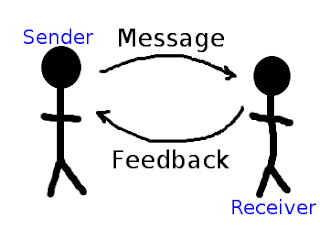In the previous post I had discussed some of the basics of communication. Today I want to discuss one of the major pillars of communication.. Listening or rather Active listening.
According to Wikipedia "Active listening is a communication technique that requires the listener to feed back what they hear to the speaker, by way of re-stating or paraphrasing what they have heard in their own words, to confirm what they have heard and moreover, to confirm the understanding of both parties."
Active Listening is not merely listening attentively to the speaker. It means listening to the message, understanding it and giving the appropriate answer or feedback. It is quite simple to become an active listener. Here are some of the ways that can help you become an active listener.
1. Pay Attention
It is the first and most important step in active listening. Pay attention to the speaker. This does not mean that you only pay attention to the words that are being spoken. The listener also need to pay attention to the tone, pitch and body language of the speaker. It is quite easy to miss the underlying thought or feeling of the speaker if we pay attention only to the words being spoken.
2. Verbal Nods
The listener needs to instill some amount of confidence in the speaker for him/her to speak freely. One of the ways to let the speaker know that you are listening is through verbal nods. Verbal nods as the name suggests means that you give some kind of acknowledgement while listening to the speaker. It could be something as simple as "Uh huh", "Ok", "I understand" etc. Verbal nods play a very important role, especially in a telephonic conversation where the speaker is not able to see the listener. Verbal nods gives the feeling of being heard and understood by the speaker. But don't overdo it.
3. Paraphrasing
It often happens that we are not clear what the speaker is trying to say for example, if the speaker is emotional (angry, upset, happy etc). In situation like these it is best to paraphrase. Paraphrase means summarizing what the speaker said in your own words. This lets the speaker knows that even if you got some information incorrect you are keen to understand what the speaker is saying. Also, when you summarize in your own words, it lets the speaker know that you are getting there and how you think through the language you use.
4. The "And.." Method
This is one of the best ways to seek more information from the speaker. When the speaker has too many things to get done or has a lot of things to say or he/she is speaking very fast, you as the listener can always control the speed of communication by using this technique. This technique can be used while there is some space in the statements of the speaker. You can politely ask "So you need to set up an account and..." You stretch the "and" so that the speaker can add or delete anything that you did not understand. It is quite effective with people who have parallel thoughts running on different things.
5. Don't Interrupt
One of the most important aspects of listening actively is not interrupting. Think about it how many times have you called your mobile phone service centre and they kept interrupting you without listening to what you needed or called for. In the same way if you kept interrupting the speaker it would irritate him/her. Not just that, we as speakers are very attached to our stories so we would not mind going back and starting from the beginning. So at the end of the speech you will have wasted a long time, listened to short story which turned long due to your interruption and on top of that you would have an irritated speaker who would still not feel satisfied because you kept interrupting.
6. Take Notes
It is a good idea to take take notes while you are listening to someone. I will help you retain any point that you may have missed while listening. Also make sure that you do not keep scribbling on your notepad while the speaker is talking, this might irritate him/her. It is important to keep a good balance between those verbal nods and taking notes.
7. Eye Contact
Eye contact with the speaker gives him confidence in you as the listener. Maintain a good eye contact when you are communicating. Make sure you don't scare the other person with too much eye contact. Keep it distant, polite and look in the eyes while listening. Don't look at your mobile or the paintings on the wall while you are being spoken to, this shows a clear disinterest in the speaker. And that communication won't go too far.
